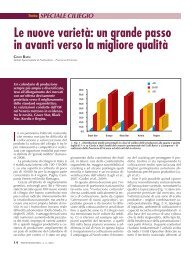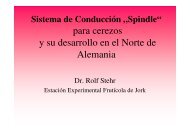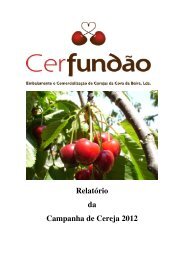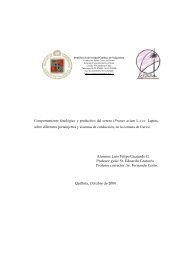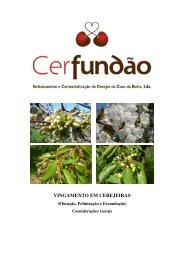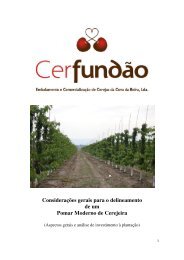Bologna university's 'Star' cherry has achieved world wide ...
Bologna university's 'Star' cherry has achieved world wide ...
Bologna university's 'Star' cherry has achieved world wide ...
You also want an ePaper? Increase the reach of your titles
YUMPU automatically turns print PDFs into web optimized ePapers that Google loves.
Prodotto - Ciliegie<br />
Product - Cherries<br />
Top Quality: <strong>Bologna</strong> university’s new breeding programme<br />
Top Quality: il nuovo programma di breeding a <strong>Bologna</strong><br />
A new breeding program began in the early 2000s with a clear<br />
objective: to obtain six or seven new varieties of high quality<br />
and similar pomological and organoleptic characteristics that<br />
could cover a period of maturation of 30-40 days. The new<br />
<strong>Bologna</strong> university project, coordinated by CRPV of Cesena,<br />
was financed by a mix of public and private funds: it was cofinanced<br />
by the Regional government of Emilia-Romagna and<br />
by New Plant, representing the three Producer Organizations<br />
Apoconerpo, Apofruit and Orogel Fresco.<br />
In order to get the project underway, a preliminary analysis was<br />
made to discover what the different players involved in the<br />
<strong>cherry</strong> supply chain (production, industry, trade and consumers)<br />
wanted of varietal innovation. Priority was given to the answers<br />
provided by consumers and traders. The inquiry found that what<br />
was wanted were varieties of high quality in pomological and<br />
organoleptic terms: large sizes, bright red skin, firm flesh, high<br />
sugar content, good resistance to handling and good shelf-life.<br />
Furthermore, industry and commerce require continuity of supply<br />
over time, high quality, and as much uniformity in the product<br />
as possible. The goal of the project thus became that of producing<br />
a high quality line of products. If the goal is <strong>achieved</strong>, the<br />
University of <strong>Bologna</strong>’s new varieties will probably be cultivated<br />
and distributed through production contracts and perhaps no<br />
longer as single varieties but through a single "trade mark"<br />
covering the whole new range.<br />
Regarding the method of breeding utilized, the choice of root<br />
stock was limited to only two or three varieties. The selection<br />
of seedlings was conducted using strict thresholds in the evaluation<br />
parameters. For example, a predominant size superior<br />
to 28 mm; skin colour 4-5 on the CTIFL scale; pulp hardness<br />
greater than 400 grams utilizing a 6mm penetrometer; a<br />
sugar level higher than 18 ° Brix.<br />
The twelve seedlings selected with these characteristics were<br />
propagated on two rootstocks (Gisela 6 and Colt).<br />
The seedling stage was immediately followed by p<strong>has</strong>e III in the<br />
(pre-commercial) selection process through the creation of two<br />
one hectare plantations in the Vignola area, each utilizing two<br />
different training systems (low multi-axis goblet and drapeau<br />
type espaglier). Two additional plantations will be established in<br />
November 2011, one in Puglia (on rootstock SL64 with a goblet<br />
shape) and one in South Tyrol (on rootsock Gisela 5 with slender<br />
spindle training). The agronomic and commercial evaluation<br />
will not be completed until 2016. The most interesting selections<br />
will be patented in the EU in the course of 2011.<br />
In parallel, work is underway to set up a consortium that will<br />
be responsible for the realization of the plantations that will<br />
be created in Italy, and subsequently to manage the marketing<br />
of this new line of cherries under a single brand. The<br />
results obtained so far bode well for the future of this important<br />
project. (L. S.)<br />
52 Fresh Point Magazine n.6 – june/giugno 2011<br />
Un nuovo programma di breeding è iniziato nei primi anni del<br />
2000 con un preciso obiettivo: ottenere sei, sette nuove varietà<br />
di qualità extra con caratteristiche pomologiche e organolettiche<br />
molto simili fra loro e in grado di coprire un calendario di maturazione<br />
di 30-40 giorni. Il nuovo progetto dell’Alma Mater, a<br />
finanziamento misto pubblico-privato, è coordinato da Crpv di<br />
Cesena e cofinanziato da Regione Emilia-Romagna e da New<br />
Plant, in rappresentanza delle tre Op Apoconerpo, Apofruit e<br />
Orogel Fresco.<br />
Per avviare questo progetto è stata condotta un’analisi preliminare<br />
sulle aspettative nei riguardi dell’innovazione varietale dei<br />
diversi soggetti coinvolti nella filiera ciliegio (produzione, industria,<br />
commercio, consumatori). Sono state considerate prioritarie<br />
le risposte fornite dai consumatori e dal commercio.<br />
Dall’indagine è emerso che sono richieste varietà con caratteristiche<br />
pomologiche e organolettiche di pregio: grossa pezzatura,<br />
buccia di colore rosso brillante, polpa soda, elevato tenore zuccherino,<br />
buona resistenza alle manipolazioni e buona shelf-life.<br />
Inoltre, l’industria e il commercio richiedono una continuità di<br />
offerta nel tempo verso una tipologia di prodotto di elevata qualità<br />
quanto più uniforme possibile. Si sta dunque lavorando per<br />
ottenere una "linea di prodotto" HQ (di alta qualità). Se l’obiettivo<br />
sarà raggiunto, le nuove varietà dell’Università di <strong>Bologna</strong> saranno<br />
probabilmente coltivate e diffuse con contratti di produzione<br />
programmati e conosciute forse non più come singola varietà,<br />
ma attraverso un unico "marchio commerciale" comprendente la<br />
nuova gamma di prodotto che si va selezionando.<br />
Per quanto riguarda le modalità operative la scelta dei parentali<br />
da utilizzare negli incroci è ricaduta su sole due, tre varietà. La<br />
selezione dei semenzali è stata condotta utilizzando severe soglie<br />
minime nei parametri di valutazione delle ciliegie. Ad esempio<br />
calibro prevalente maggiore a 28 mm; colore epidermide scala<br />
4-5 Ctifl; durezza della polpa maggiore di 400 grammi al penetrometro<br />
6mm; zuccheri maggiori a 18° Brix.<br />
I dodici semenzali selezionati con queste caratteristiche sono<br />
stati propagati su due portinnesti (Gisela 6 e Colt).<br />
Dal semenzale si è passati direttamente alla fase III di selezione<br />
(pre-commerciale) realizzando due impianti nel vignolese di un<br />
ettaro di superficie ognuno con due forme di allevamento (vaso<br />
basso multiasse e bandiera). Altri due impianti saranno realizzati<br />
nel novembre 2011, uno in Puglia (su SL64 con forma a vaso)<br />
e uno in Alto Adige (su Gisela 5 a fusetto). La valutazione agronomica<br />
e commerciale potrà ritenersi conclusa intorno al 2016.<br />
Le selezioni più interessanti saranno brevettate a livello Ue nel<br />
corso del 2011.<br />
In parallelo, si sta lavorando per realizzare un consorzio che avrà il<br />
compito di programmare gli impianti da realizzare in Italia e gestire<br />
successivamente la commercializzazione a marchio di questa<br />
nuova linea di ciliegie. I risultati fin qui ottenuti lasciano ben sperare<br />
in un esito positivo di questo importante progetto. (S. L.)



